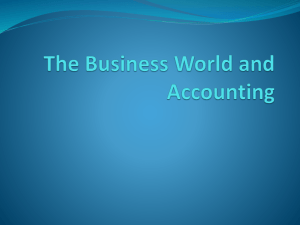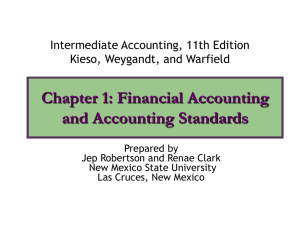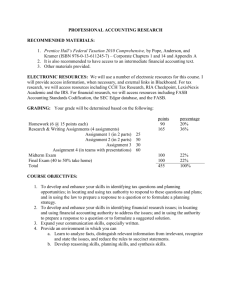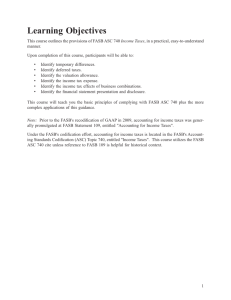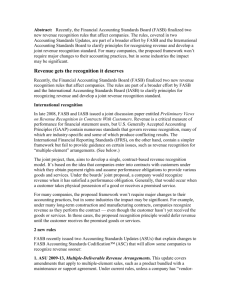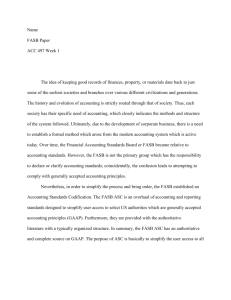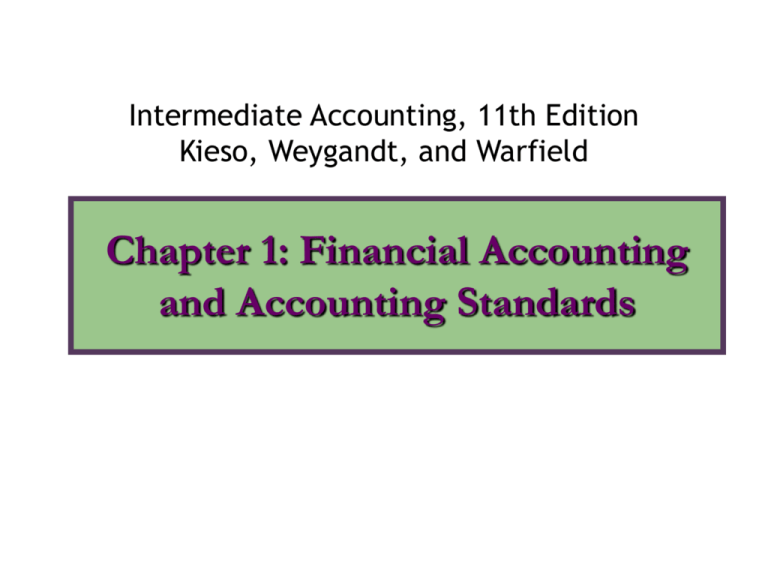
Intermediate Accounting, 11th Edition
Kieso, Weygandt, and Warfield
Chapter 1: Financial Accounting
and Accounting Standards
Chapter 1: Financial Accounting
and Accounting Standards
After studying this chapter, you should be able
to:
1. Identify the major financial statements and
other means of financial reporting.
2. Explain how accounting assists in the efficient
use of scarce resources.
3. Identify some of the challenges facing
accounting.
4. Identify the objectives of financial reporting.
Chapter 1: Financial Accounting
and Accounting Standards
5. Explain the need for accounting standards.
6. Identify the major policy-setting bodies and
their role in the standards-setting process.
7. Explain the meaning of generally accepted
accounting principles.
8. Describe the impact of user groups on the
standards-setting process.
9. Understand issues related to ethics and
financial accounting.
Characteristics of Financial
Accounting
• Accounting identifies, measures and
communicates financial information.
• This information is about economic entities.
• Information is communicated to interested
parties such as investors, creditors, unions
and governmental agencies.
Accounting and the Efficient Use
of Scarce Resources
Financial Reporting aids users in
the allocation of scarce
resources.
Objectives of Financial Reporting
by Business Enterprises
The objectives are specified in Statement of
Financial Accounting Concepts No. 1.
The objectives are as follows:
• Information provided must be useful in
investment and credit decisions.
• Information must be useful in assessing cash
flow prospects.
• Information must be about enterprise resources,
claims to those resources and changes therein.
Generally Accepted Accounting
Principles (GAAP)
• The profession has developed GAAP
that present fairly, clearly and
completely the financial operations
of the enterprise.
• GAAP consist of authoritative
pronouncements issued by certain
accounting bodies.
The Standard Setting Process:
Parties Involved
• Securities and Exchange Commission (SEC)
• American Institute of Certified Public
Accountants (AICPA)
• Financial Accounting Standards Board
(FASB)
• Governmental Accounting Standards Board
(GASB)
The Financial Accounting
Standards Board (FASB)
• The FASB enjoys the following advantages
compared to its predecessor, the
Accounting Principles Board:
* smaller membership
* greater autonomy
* increased independence of members
* broader representation on the Board
FASB
Due Process
• In establishing financial standards, the FASB
follows a due process procedure.
• The due process procedure gives time to
interested persons to make their views
known to the Board.
FASB
Due Process
2
1
AGENDA
Topics for
standard
setting are
identified
Discussion
Memorandum
The FASB
issues
initial
research and
analysis
4
3
Public
Hearing
A public
hearing
is
conducted
FASB
Due Process
4
Exposure
Draft
The FASB
issues
an exposure
draft
(tentative
standard)
5
Final Standard
The FASB
evaluates
responses and
issues the
final
standard
Major Types of FASB
Pronouncements
•
Standards and Interpretations
•
Financial Accounting Concepts
•
Technical Bulletins
•
Emerging Issues Task Force Statements
Organizational Structure for
Setting Standards
Financial
Accounting
Foundation
FASB
Financial
Accounting
Standards
Advisory
Council
GASB
Staff and
Task Force
Governmental
Accounting
Standards
Advisory
Council
House of GAAP
Challenges Facing Financial
Accounting
• Non-financial measurements need to be
developed and reported.
• More information needs to be provided
regarding soft assets (intangibles).
• Forward-looking information, in addition to
historical information, must be provided.
• Statements may have to be prepared on a
real-time basis (and not just periodically).
The Expectations Gap
An expectations gap exists between the
• public’s perception of the profession’s
accountability and profession’s perception of
its accountability to the public.
Corrective steps include the setting up of the:
• SEC Practice sections and
• Public Oversight Board.
International Accounting
Standards
• The International Accounting Standards
Committee (IASC) was formed in 1973.
• The objective was to narrow divergence in
international financial reporting.
• There are many similarities between U.S.
and International accounting standards.
• The concern is that international standards
may not be as rigorous as U.S. standards.
COPYRIGHT
Copyright © 2004 John Wiley & Sons, Inc. All rights reserved.
Reproduction or translation of this work beyond that permitted
in Section 117 of the 1976 United States Copyright Act without
the express written permission of the copyright owner is
unlawful. Request for further information should be addressed
to the Permissions Department, John Wiley & Sons, Inc. The
purchaser may make back-up copies for his/her own use only
and not for distribution or resale. The Publisher assumes no
responsibility for errors, omissions, or damages, caused by the
use of these programs or from the use of the information
contained herein.


